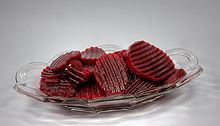Pickled vegetables
Sour vegetables are the collective term for vegetables that are preserved by lactic acid fermentation or vinegar and salt. The sour pickling changes the taste, aroma and consistency of the products, which can also be fruit, eggs, meat, fish and cheese. In East Asia, a mixture of vegetable oil and vinegar is also used for pickling , a vinaigrette .
In contrast to the canning process , sourly pickled products do not have to be pasteurized or cooked for preservation . As a rule, a pH value below 4.6 is aimed for. This prevents most of the harmful bacteria from multiplying and can keep canned food for many months.
Supportive can antimicrobial acting herbs and spices such as mustard seeds , garlic , cinnamon and cloves are added.
Fermented vegetables
The original process, in which the acid is produced through fermentation , has been known in both Asia and Europe for millennia . To do this, raw vegetables are mixed with salt and pressed, whereby liquid escapes and seals the vegetables from the air. Depending on the moisture content and consistency, water may still have to be added to obtain a sufficient amount of brine . In this environment, the glucose contained in the plants is converted into lactic acid by anaerobic lactic acid bacteria via intermediate steps . The exclusion of air and the salt and acid content prevent most of the other, above all aerobic bacteria from multiplying and thus prevent the formation of rot.
Depending on the acid, salt and oxygen content as well as the storage temperature, different microorganisms dominate and determine the taste of the end product. At a low temperature and salt content, Leuconostoc mesenteroides predominates and, in addition to lactic acid and carbon dioxide, also produces alcohol and various aromatic substances . At higher temperatures, Lactobacillus plantarum dominates and produces lactic acid. The fermentation is often initially determined by Leuconostoc bacteria, until Lactobacillus predominates as the acidity increases .
Since the vegetables are not cooked with this method of preservation, most of the vitamins (especially vitamin C ) are retained. During the winter, pickled vegetables were for a long time one of the most important sources of vitamins in regions where, for climatic reasons, a year-round vegetable harvest is not possible. Sauerkraut has been a staple in the shipping industry since James Cook , as it prevented the development of scurvy and had a long shelf life.
Typical lactic acid-fermented vegetables are sauerkraut , pickled cucumbers, sour beans and beets , tsa tsai , gimchi and tsukemono . Also squash , peppers and radishes be preserved that way.
In the course of the 20th century , fermented vegetables have lost much of their importance due to newer preservation methods such as boiling or canning and deep freezing, as well as due to greenhouse cultures and the year-round worldwide trade in food.
Pickled vegetables
Vinegar vegetables are placed in a boiled brew of vinegar water with salt, spices, herbs, natural flavors, sugars and sweeteners, which has a preservative effect without fermentation, as long as the vegetables are sealed off from the air and finally pasteurized . As a rule, the infusion contains a maximum of 2.5% acetic acid and a pH value of less than 4.2.
Typical pickles are pickled cucumber , gherkins, mustard pickles , beets , onions , Puszta salad and pickles . Unlike fermented vegetables, they are not primarily used as a staple food, but above all as appetizing side dishes.
See also
Web links
Individual evidence
- ^ Lillian Chou: Chinese and other Asian Pickles. In: Flavor and Fortune (Fall 2003 Volume). Institute for the Advancement of the Science And Art Of Chinese Cuisine, accessed December 6, 2012 .
- ↑ Pickle Bill Fact Sheet. (No longer available online.) March 13, 2008, archived from the original on March 13, 2008 ; accessed on February 15, 2018 .
- ^ MS Rhee, SY Lee, RH Dougherty, DH Kang: Antimicrobial effects of mustard flour and acetic acid against Escherichia coli O157: H7, Listeria monocytogenes, and Salmonella enterica serovar Typhimurium . In: Appl Environ Microbiol . tape 69 , no. 5 , 2003, p. 2959-2963 , doi : 10.1128 / aem.69.5.2959-2963.2003 , PMID 12732572 , PMC 154497 (free full text).
- ^ A b Harold McGee: On Food and Cooking: The Science and Lore of the Kitchen. Scribner, New York 2004, ISBN 0-684-80001-2 , pp. 291-296.
- ↑ aid infodienst e. V. (Ed.): Password food. 3. Edition. 2010, ISBN 978-3-8308-0935-7 .

